Hello everyone, and welcome back to Insider Trading! In last week’s article, I gave a brief history of Foreign (read: non-English) Magic cards. In this week’s article, I’m going to highlight eight Foreign Magic misprints, rarities, and oddities. Did you think that only the Revised Serendib Efreet got wrong artwork? Well my friends, you’re in for a whole world of strange this week!
A special thank you in advance to Squt from Squt’s Misprint Page for some of the images used in this article! Also thank you to the MagicLibrarities.com community for the fact-checking I did in writing parts of this article!
1) Spanish 4th: Serra Angel/Time Elemental
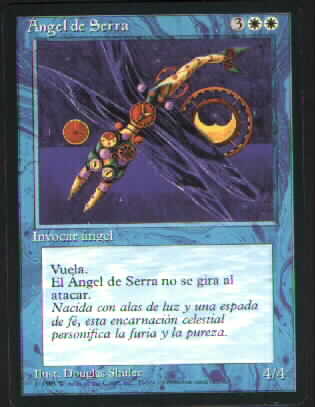
One of the most famous misprints is the 4th Edition Spanish Serra Elemental. You see, this isn’t just any misprint – it’s a cock-up that saw Serra Angel’s text printed on the artwork for Time Elemental! Considering that Serra Angel’s original artwork is/was one of the most iconic pieces in all of Magic, you’d figure that quality control would catch this problem. But alas, they did not! This misprint is one of the most sought-after and currently fetches between $30 and $50 on the open market.
2) Italian Legends Rule Card


Here we have pictured the rules cards for Legends – one for English Legends and one for Italian Legends. The English Legends rules card was included in every pack of Legends – you bought a pack, you automatically got a card explaining the new Legends rules, such as Bands with Others, Rampage, and Enchant World (wheee!). These cards are worth about a quarter each.
Then you have the Italian Legends rules card. Unlike the English version of the card, the Italian Rules card was not inserted into packs. Instead, Italian storeowners were sent rules cards in the mail, and told to hand them out to customers as Legends packs were sold. The majority of these cards made their way straight to the trash. As a result, the Italian Legends rules card is quite hard to come by. While most people wouldn’t care much about a rules card, this is a Magic item that many a rarity collector would like as part of their collection. We came across a few of these back in 2005, and sold out of them within a week at $50 each.
3) Gotta Magazine Archangel
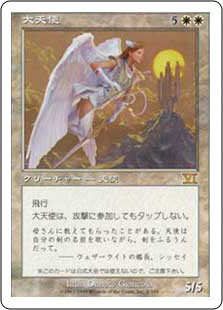
As part of the celebration for 6th Edition, Gotta Magazine (basically an Inquest/Scrye type-magazine in Japan) commissioned an alternate-art Archangel card, printed it on a glossy stock with a non-Magic back, and inserted it into their magazine. This is the only version of Archangel officially released with this artwork. Other cards in this series include Thorn Elemental, Ascendant Evincar, and Parallax Dementia (WHY?). The non-tournament legal, alternate-art Archangel fetches around $50-$60, thanks to the popularity of Angels worldwide.
4) Drudge Swamp
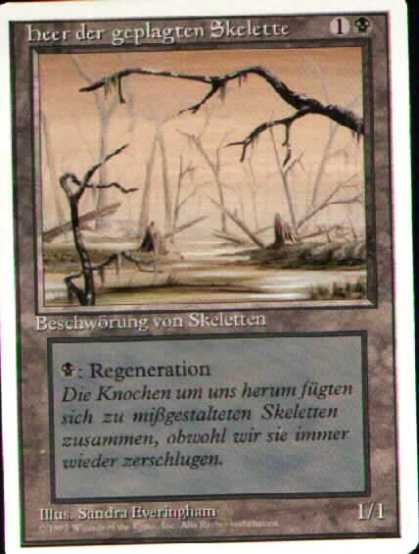
There were a lot of misprints back in the early days of Magic, several along the lines of the Serra Elemental misprint from Spanish 4th Edition. This misprint is the Drudge Skeleton text printed on the Swamp artwork from FWB German 3rd Edition. If this were a Swamp on the Drudge Skeleton, it’d be a lot niftier, because people tend to play Swamps more than Drudge Skeletons. Since it’s the other way around, and this was printed on all the versions of Drudge Skeleton, and it’s a common, it’s only worth around $5.
5) Wald (Forest/Plains)
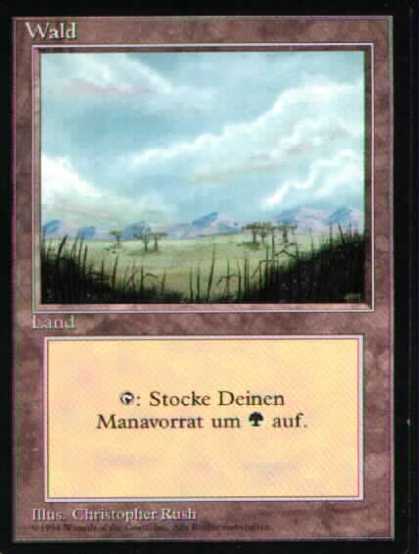
This one is really cool – look closely at the text box for this card! That’s right – in FBB German Revised, one of the Forests was printed on the artwork of a Plains! Back in the day, the rule of law was that you played misprints as text they have on them, and not the picture pictured. This meant that a Wald (Forest/Plains) was a Forest, even though it looked like a Plains.
This led to the German Wald (as it’s often called) being highly coveted by players, at least along the East Coast. Erhnamgeddon was a popular White/Green deck at the time, and so players would try to get black-bordered lands that all had the same picture – German Walds for Forests (that looked like Plains), and a version OF that Plains from either French or Italian Revised. Players would then stack their lands like they would any other mana, and if your opponent wasn’t paying attention, you’d suddenly start ‘casting’ Erhnam Djinn on turn 4 with no apparent Forests in play!
While this flew back in the day, eventually Wizards ruled it unsporting to intentionally try to misrepresent your cards via misprinted artwork. If you intentionally tried to get away with running the old “Wald” trick in a tournament these days, your reward is likely to be a DQ, either for cheating, or for unsporting – Major. Because they are more of a curiosity (or a neat trick to play on unsuspecting friends) than a tournament Jedi-mind-trick strategy these days, the German Wald goes for around $5.
6) The Chinese No-Skeleton Rule
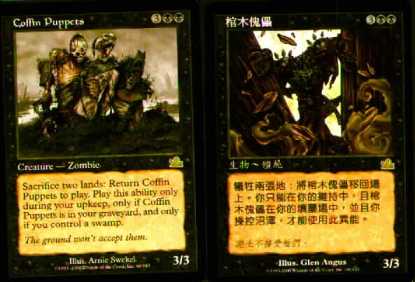
Last week, I discussed how the Chinese government had essentially banned the depiction of human skeletons on Magic artwork. One of the early examples of redone artwork was Coffin Puppets from Prophecy. Pictured above are the English and Asian versions of Coffin Puppets – yes, they are the same card, but no, you would never, ever be able to tell that just by looking at the art! There are dozens of examples of alternate Chinese artwork of this kind, but Coffin Puppets is one of the most striking. These are sought after by collectors to the tune of around $5 each, since they feature artwork not otherwise found on English versions of cards. Other de-skeletonized artworks simply apply a photoshop (or touch-up) job to putting skin on a skeleton (making it look like more of a zombie), and are not in as high demand.
7) The missing cards from Chinese and Korean 4th Edition
Some time a few years ago, we had a customer contact us about creating a bunch of Korean complete sets for him. We had quite a number of Korean cards around the office at the time, so the StarCityGames.com crew went about the task of putting these sets together! We had almost all of 4th Edition, including all of the Rares. However, five cards eluded us – Blood Lust, Fire Elemental, Gaseous Form, Lost Soul, and Shanodin Dryads. This was quite odd, as A) we had dozens of copies of each other Korean Common and half-a-dozen of most Uncommons, and B) we had every Rare in the set!
After more than a bit of digging, we unearthed a stark fact – those five cards were not printed in either Chinese or Korean 4th Edition (but were in Japanese!) All of five of those cards have women depicted in the artwork, so this is likely related to the Chinese Skeleton censorship that frequently rears its head. If you’re ever building a 4th Edition Black-Bordered Korean or Chinese set, remember that you’ll have five fewer cards than in your English version of the same set when all is said and done!
8) Renaissance
When I said last week that Portal Three Kingdoms was the first set uniquely printed outside of the United States market, that was only a half-truth. There was a set known as Renaissance printed in German, French, and Italian (the three languages of Black-Bordered Revised). These sets were black-bordered reprints of cards that were entering into 4th Edition, but had not been printed in Revised (such as Land Tax, Sylvan Library, and Whirling Dervish). All of these cards were from Arabian Nights, Antiquities, Legends, The Dark, and Unlimited. However, you might recall that there were two foreign language releases predating Revised – Italian Legends and Italian Dark (you did read last week’s article, right?). So for the German and French versions of Renaissance, you ended up with those cards. You also had the Italian version of Renaissance, which had an entirely different card list!
German/French Renaissance: Arabian Nights/Antiquities/Legends/The Dark and Unlimited Cards that were printed in 4th Edition, but did not appear in Revised.
Italian Renaissance: Antiquities/Arabian Nights/Unlimited cards that were printed in both 4th Edition and Chronicles, but did not appear in Revised.
So the Italian Renaissance set was smaller, but included Chronicles cards such as the Urza’s lands, whereas the German and French Renaissance sets were smaller, did not have the Urza’s lands, but did have cards like Land Tax (which the Italian Renaissance set did not have, since Land Tax was printed in Italian Legends).
And with that, I bid you adieu! As of next week, this column is making a permanent move to Thursdays, so I’ll see you in eight days!
Ben

